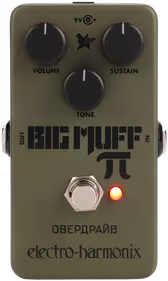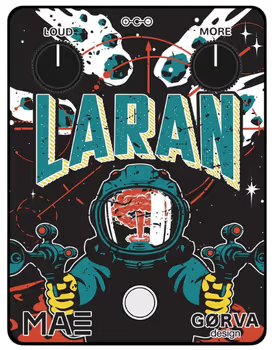
Electro Harmonix Nano Big Muff Series: All 6 Big Muffs Compared
I’ve loved Big Muffs since I started my first band (back in the days of 2008).
I only knew that my favorite bands like the White Stripes, Black Keys, Dinosaur Jr., Smashing Pumpkins, Wolfmother all use some version of this box for most of their signature sounds.
Only years later, Electro Harmonix released the Big Muff Nano Series. A series of Big Muff reissues that pretty much covers all the highlights of EHX’s history of Big Muffs. And all of them are housed in a cute, pedalboard-friendly nano-sized enclosure.
To the outsider, comparing all these versions of the same base circuit might seem like cork-sniffery.
When I realised my idea to do a back-to-back comparison of all these versions, I was surprised by how different all of these variants actually sound.
Big Muff Pi (NYC)
This is the classic that most people of my generation are familiar with. It’s identical to the big box NYC version.
Most bands that recorded in the 90s, 2000s and 2010s probably have used this circuit or a version close to it live and in studio.
The highs are less pronounced compared to the other variants. There is plenty of mid scoop happening.

Buy through these links and support Loopy Demos
at no extra cost to you.
Green Russian Reissue
This version definitely has my favorite enclosure design. It looks so rugged and vintage. The tone definitely delivers for the vibes as well.
I first heard about this version when I researched Dan Auerbach’s (Black Keys) gear. I was absolutely fascinated by the raw tones he got on their early records (e.g. Magic Potion).
The Green Russian has a little less mid-scoop, an overall warmer tone and a little less gain than most other variants in this series.
I liked the feel of this a lot when recording the demo track.

Buy through these links and support Loopy Demos
at no extra cost to you.
Op-Amp Reissue
Made famous by Billy Corgan from the Smashing Pumpkins (that’s why it’s orange), the Op-Amp Big Muff sounds beautifully nasty.
Instead of transistors, this variant uses operational amplifiers to produce it’s cascading gain-staging and clipping.
Out of the whole series, this is the most unique/extreme sounding. The mid-scoop is far more pronounced, there is more sizzle and white noise happening in the high end and the lows are much more booming.
Additionally, it has a toggle switch to bypass the tone stack entirely. This makes it more raunchy and open sounding. This mod brings back mids into the mix and might make it more usable in a live band mixing situation.
If you want to channel your inner mix of angst and aggression, this is the pedal for you.

Buy through these links and support Loopy Demos
at no extra cost to you.
Triangle Reissue
This is a faithful recreation of the original V1 from 1969.
Sonically, I would place the Triangle between the NYC and the Ram’s Head. The highs are a bit smoother than the Ram’s Head version. The lows seem a bit more tidied up compared to the NYC version. But there is also some upper mid texture happening that I’m not hearing on the NYC.

Buy through these links and support Loopy Demos
at no extra cost to you.
Ram’s Head Reissue
This is my favorite from the whole series. I’m hearing significantly more highs and upper mids and less of a mid scoop.
For my personal taste, this is the most balanced and most usable variant for a full-band context.
A little behind the scenes: When I started gathering the EHX Big Muffs from this series, this was the first one to arrive at my house. I have played the NYC version in the past and also tried a lot of fancy boutique Big Muff variants.
When I plugged in the Ram’s Head, I immediately liked it and knew that I wanna keep it because it just felt like a really good fuzz.
I absolutely get now why the Ram’s Head is J. Mascis’ (Dinosaur Jr.) favorite Big Muff.

Buy through these links and support Loopy Demos
at no extra cost to you.
Bass Big Muff
This might be an odd thing to throw into a comparison with a guitar track. The Bass Big Muff was of course designed for bass. You can hear it on bass in my bass distortion shootout (spoiler alert: it slays).
But I do think it has merit as a guitar pedal. Hear me out!
It’s based on the Green Russian. There is actually less low-end on the Bass Big Muff than the Green Russian. And it has noticeably less gain than the Green Russian.
If you flip the toggle to the right, the volume knob becomes a blend knob. All the way clockwise means 100% fuzz, and counter-clockwise brings back the clean signal. That’s where the low end is coming from with a bass.
On guitar, this transforms the Bass Big Muff into something than can actually deliver a more tamed sonic palette. With just a little clean guitar mixed back in, you gain a little more clarity and an overall less compressed sound.
If you keep the toggle to the left, you simply get a lovely Green Russian variant. I would even go so far as to say, that I like this more than the classic NYC version.

Buy through these links and support Loopy Demos
at no extra cost to you.
Signal Chain
- Fidelity Guitars Stellarosa Lite II with Lollar Firebird pickups (bridge pickup)
- Big Muff
- Mixwave Benson Chimera Plugin*
- A bit of room-like reverb from the Valhalla Vintage Verb plugin
*Affiliate links: If you buy something through these links, you’re supporting Loopy Demos without any extra cost for you. Thank you!
Discover More In-depth Demos




















